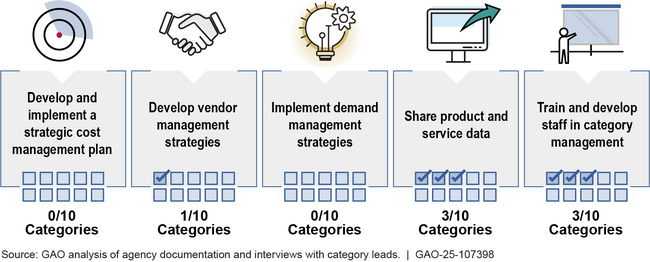VA Acquisitions: Leadership Accountability and Savings Goals Needed to Improve Purchasing Efficiency
Fast Facts
The Department of Veterans Affairs and other federal agencies can buy goods and services in bulk across common categories, like medical and IT. This helps them use the buying power of the government to save taxpayer dollars.
But VA isn't getting the full benefit of this "category management" approach. For example, VA category management officials aren't required to take relevant training. There also isn't a way to hold them accountable for effectively implementing the approach. As a result, VA could be using it inconsistently and missing opportunities for more cost savings.
Our recommendations address these issues and more.
A VA Medical Center in Aurora, CO

A photograph of a VA medical center building made of concrete and glass and situated on a street corner.
Highlights
What GAO Found
The Department of Veterans Affairs (VA) has a policy encouraging purchasers of common goods and services to leverage the government’s buying power and save taxpayer dollars. In 2020, VA assigned roles and responsibilities to implement an effort led by the Office of Management and Budget (OMB), called category management, designed to help federal agencies buy like a single enterprise. VA assigned officials to manage 10 common spending categories, such as medical and IT goods and services. Each category manager was also tasked with implementing five key responsibilities aligned with OMB guidance.
GAO found, however, that these officials and those assisting them—known as category leads—generally did not fulfill their responsibilities because senior leaders responsible for oversight did not take steps to ensure they did so. Until senior VA leaders hold these officials accountable, VA will struggle to consistently implement its category management policy and take important steps that could result in savings, reduced contract duplication, or other benefits.
Extent to Which Department of Veterans Affairs Category Management Leadership Met Key Responsibilities in Policy, as of February 2025

VA met most of its annual category management goals set by OMB from fiscal years 2020 to 2024. For example, 91.7 percent of VA’s $67.2 billion in contract obligations in fiscal year 2024 were on contracts considered to be managed according to category management principles, exceeding its goal of 90 percent. VA reported savings for governmentwide contracts that accounted for 7.6 percent of its fiscal year 2024 contract obligations. However, category leads told GAO that they did not set or manage toward category-specific savings goals. Doing so could help VA leverage its buying power to save taxpayer dollars and quantify the return on investment for a larger share of its category management efforts.
VA met annual goals set by OMB for training its workforce on category management principles. However, GAO found that key officials, including leads for seven of 10 spending categories, had not taken such training. Until VA ensures that key officials—including category managers and category leads—receive training that is relevant for their roles, the agency will struggle to fully implement its category management policy.
Why GAO Did This Study
According to the General Services Administration, the government achieved $58.3 billion in cost avoidance through OMB’s category management initiative from fiscal years 2021 through 2024. VA reportedly accounted for $14.3 billion of this amount. The government’s pursuit of additional savings and efficiency remains critical in the face of increasing budgetary pressures.
GAO was asked to review VA’s progress in implementing category management. Among other objectives, this report identifies the extent to which VA (1) implemented category management policies and processes, and (2) achieved intended category management outcomes.
GAO reviewed VA policies, procedures, and plans, and OMB’s category management guidance; analyzed VA contract and category management data between fiscal years 2019 and 2024 and assessed progress against established goals; and interviewed VA officials, including those responsible for managing VA’s 10 common spending categories and VA contracting activities.
Recommendations
GAO is making six recommendations to VA, including that VA (1) establish performance requirements to hold category managers accountable for their responsibilities, (2) establish category-specific savings goals, and (3) ensure that key category management officials take training relevant to their roles. VA concurred with all six recommendations.
Recommendations for Executive Action
| Agency Affected | Recommendation | Status |
|---|---|---|
| Department of Veterans Affairs | The Secretary of Veterans Affairs should ensure that the Deputy Secretary, as the category management senior accountable official, establishes performance requirements to hold category managers accountable for fulfilling their respective category management responsibilities established in VA policy. (Recommendation 1) |
When we confirm what actions the agency has taken in response to this recommendation, we will provide updated information.
|
| Department of Veterans Affairs | The Secretary of Veterans Affairs should ensure that the Deputy Secretary, as the category management senior accountable official, establishes the category management council, or designates an existing entity to perform the duties of the category management council, as described in VA policy to guide the implementation, coordination, and oversight of VA's category management initiative. (Recommendation 2) |
When we confirm what actions the agency has taken in response to this recommendation, we will provide updated information.
|
| Department of Veterans Affairs | The Secretary of Veterans Affairs should ensure that the Deputy Secretary, as the category management senior accountable official, and in coordination with the Chief Acquisition Officer and Senior Procurement Executive, identifies the category management training required for specific roles, including category managers, category leads, and officials identified as having requirements responsibilities, and ensures those officials complete required training. (Recommendation 3) |
When we confirm what actions the agency has taken in response to this recommendation, we will provide updated information.
|
| Department of Veterans Affairs | The Secretary of Veterans Affairs should ensure that the Deputy Secretary and category managers establish category-specific goals for cost avoidance and budget savings, and track progress toward these goals. (Recommendation 4) |
When we confirm what actions the agency has taken in response to this recommendation, we will provide updated information.
|
| Department of Veterans Affairs | The Secretary of Veterans Affairs should ensure that category managers assess the availability of, or feasibility of making available, item-level data on prices paid, utilization, and cost avoidance to facilitate use of such data to track cost avoidance within the department's common spending categories. (Recommendation 5) |
When we confirm what actions the agency has taken in response to this recommendation, we will provide updated information.
|
| Department of Veterans Affairs | The Secretary of Veterans Affairs should ensure that the Deputy Secretary, as the category management senior accountable official, ensures that category managers, in conjunction with heads of contracting activities, develop and maintain vendor management plans for their respective categories, that identify mission-critical functions and associated contractors and include strategies to address supply base risks. (Recommendation 6) |
When we confirm what actions the agency has taken in response to this recommendation, we will provide updated information.
|
